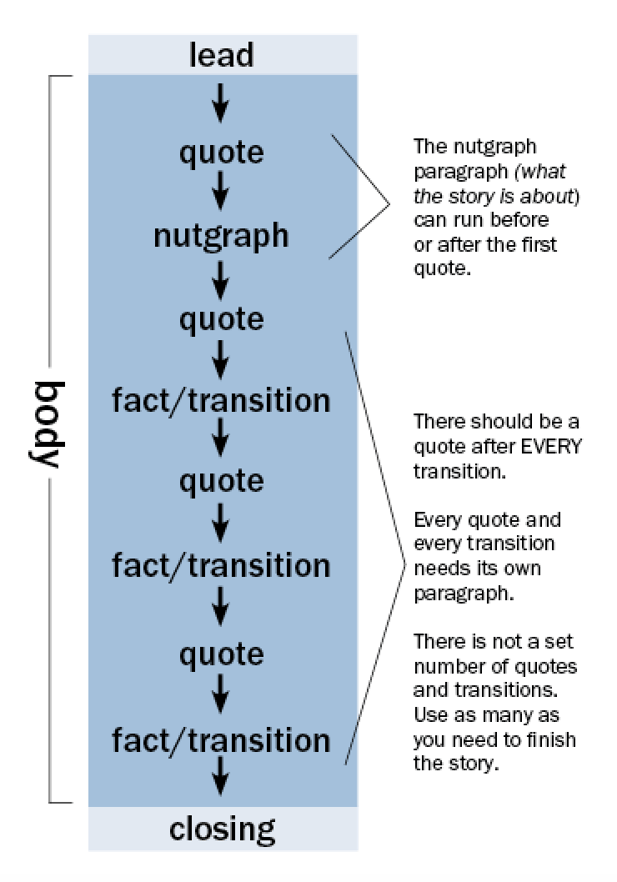
It’s the least looked at element on the page. But it’s probably the most important. One of the primary functions of a yearbook is to tell the story of the year. To do that, we have to gather information and write compelling stories.
Step 1: Get the whole story
One reason students struggle writing stories is they don’t gather enough information. It’s important to start with the 5Ws and H (who, what, when, where and how) and then expand on them. Ask for additional details and encourage interviewees to tell you more. Sources don’t always elaborate and it’s the reporter’s responsibility to dig deeper. Often students gather the background and factual information but forget to ask for opinions. While the facts are essential to the backbone of a story, it’s the emotions and opinions that will be the heart of it. Make sure questions address both.
Start with 10 prepared questions, beginning with basic information and easy queries. Ask for additional detail along the way, gently prodding the source to explain more. Move to more complex questions as the interviewee becomes more comfortable. Don’t be afraid to ask impromptu questions based off an answer. These usually lead to the best anecdotes and quotes. Always thank the source at the end and leave the door open to follow up if additional questions come up. Ask for suggestions on other people to interview.
Strive to interview at least three sources for every story. This will give the story balance and ensure the writer has additional perspectives. And it’s much more likely the story will provide a more complete picture of the topic, event or person profiled.
RELATED: Check out this interview tip sheet.
Step 2: Grab their attention
After collecting all the information, it’s helpful to go over the notes. Find the most interesting fact the source said and cultivate that for the introduction. The lead is the first part of a story to entice the reader to continue reading.
An easy mistake is to write a summary sentence, like a thesis statement about what the story is about. But that won’t grab a reader’s attention. (Save that sentence for the nutgraph paragraph that goes after the lead or first quote.)
Instead, write a strong feature lead that hooks the reader. It could be a narrative or anecdotal lead that provides rich imagery and details setting the scene. It could be a contrast lead that provides striking differences. It could be a startling statement lead to shock the reader. A roundup lead provides a list of things to entice the reader to keep going.
Avoid starting with a question or a quote. Have you ever started a story with “Have you ever?” Let’s avoid this cliché too. These starts are overused and take little imagination or effort. Speaking of imagination, don’t ask the reader to “imagine” something. The writer’s job is to show, not tell. Do a great job setting a scene and the reader will have no problem conjuring up the image in their head. Also, avoid using first or second person (I, we, you) which brings the reporter into the story; stick with third person.
Step 3: Follow a formula

Strong stories follow a story formula to keep the reader engaged. Story formula, also called quote transition formula, presents the facts and quotes in an order to move the reader through the story. Essentially, every transition is followed up by a quote expanding on that transition. This formula of transition, quote, transition, quote, etc. continues until the entire story is told.
The transitions provide facts and paraphrase indirect quotes. This is where having a detailed interview helps. Reporters will need factual information to fill in the details of the story. The transitions also help the reader move smoothly from one part of the story to the next (Hence, why they’re called transitions).
The quotes are emotions, thoughts, opinions and reflections of the facts. The quotes should NOT be facts. Save that information for the transition paragraphs and use all the source’s best thoughts and opinions for the quotes. Strive to have multiple quotes from multiple sources in stories.
To help the story flow and to keep the reader’s attention, we recommend keeping quotes and facts in separate paragraphs and making sure there is a quote after every fact/transition paragraph.
Step 4: Leave your opinion out of it
It’s really important to keep personal opinions out of the story. This means avoiding cheerleader-like statements “they worked hard” or “tried their best.” Reporters need to remain objective to be a reliable and trustworthy source of information. The lead, nutgraph and all transitions should omit any opinions. Save all the opinions for the quotes.
Step 5: Have a strong conclusion
One of the best ways to wrap up a story is with a strong, ending quote. Save a great quote from the interview that is a strong note to end on. Another option is a final sentence to tie the ending back to the lead, leaving the reader with a sense of closure.
Following these suggestions will help improve students’ feature writing skills. Another tool to help writers is a writing rubric. Consider having editors use it as they proofread stories and it’s also a helpful for grading. Happy writing!

